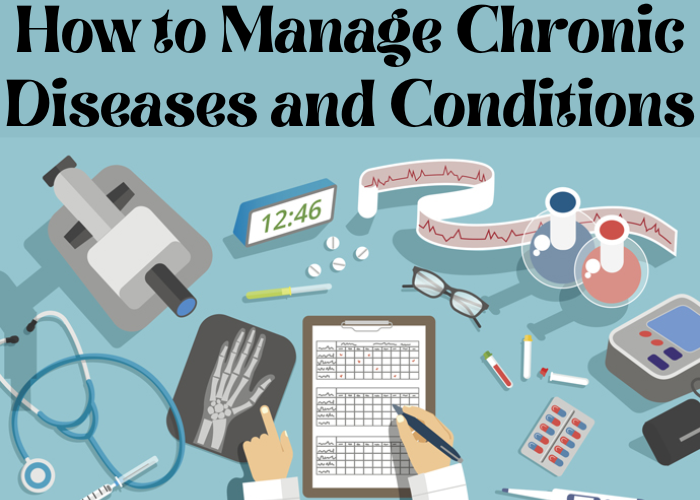Chronic diseases and conditions can be hard to manage, but there are plenty of ways you can take control. Here are some tips on how to manage your blood pressure and diabetes with diet, exercise, and other lifestyle changes.
Manage Your Blood Pressure
Blood pressure is the force of blood against the walls of your arteries. It’s measured by taking a reading from a cuff on your arm and is calculated as the amount of force necessary to make your blood squirt out of its vessels.
In general, when people talk about “high” or “low” blood pressure, they’re referring to systolic vs diastolic levels-. The top number being systolic (the first number) and bottom number being diastolic (the second number). A normal reading is 120/80 mmHg; anything above 140/90 mmHg can signal hypertension (high blood pressure). If you have any doubt about whether you have high BP, consult with your doctor immediately!
High BP has been linked with an increased risk for heart attack, stroke and kidney failure in addition to other complications such as nerve damage from diabetes mellitus–a condition characterized by high levels of sugar in urine that may cause nerve damage over time if left untreated.
Take Charge of Your Diabetes
- Monitor your blood sugar levels.
- Know the difference between high and low blood sugar levels.
- If you have high or low blood sugar levels, be sure to eat something with enough glucose (sugar) in it to help bring your level back up to normal.
- The best thing you can do if you’re feeling shaky after eating is to take a quick break from eating altogether so that your body can get some rest before digesting food again later on; this will also help prevent hypoglycemia from happening as well! If this happens every once in a while, then just listen closely for any signs of shakiness–they might not even be present until after hours of fasting (which makes sense). Start by taking small sips of water instead of large gulps whenever possible; this will help keep things moving along more smoothly than if we try forcing ourselves into drinking massive amounts right away!
Monitor Your Heart Health
- Monitor your blood pressure.
- Take your blood pressure medications as prescribed by your doctor.
- Eat a healthy diet and exercise regularly.
- Stop smoking (or at least cut down), if you’re not already doing so–it’s good for you, but also great for managing chronic disease!
- Keep stress levels low by learning how to meditate or practicing yoga or tai chi regularly
Manage Your Weight and Nutrition
- Eat a healthy diet. The best way to manage your weight is to make sure that you eat properly, which means eating lots of fruit, vegetables and other plant-based foods. You should also limit salt, saturated fat and sugar in your diet.
- Exercise regularly. Regular exercise can help reduce your risk for chronic diseases like heart disease or diabetes by increasing blood flow throughout the body; it also lowers stress levels and improves sleep quality!
Look After Your Eyes
- Wear sunglasses. If you can’t see your own face, then the rest of the world will look pretty strange too.
- Use computer glasses if you have to read or write in dim light for long periods of time (like at work).
- Get an eye exam every year to check for any signs of vision loss and changes in prescription lenses over time. This is especially important if you’ve been experiencing problems with your eyesight recently–if something seems off, get it checked out!
- Avoid reading or viewing TV at close distances (within arms’ reach) because this can worsen vision problems like cataracts or macular degeneration (a common cause of blurry vision).
You should also avoid staring directly at bright sunlight or watching television too close to your face because both activities are known risk factors for developing glaucoma–an eye disease that causes pressure buildup inside their eyeballs causing temporary blindness due to damage caused by increased intracranial pressure over time
Stay Hydrated, Even When You’re Not Thirsty.
Take a break from the caffeine, alcohol and sugary drinks. Be sure to drink water throughout the day–even when you feel like you don’t need it. But especially if you’re feeling sluggish or not quite yourself.
You may think that drinking more water only makes things worse, but surprisingly enough it can actually help with many chronic conditions by keeping your body hydrated and making certain organs function better. The kidneys are one example: they require extra fluid in order to keep up with all those toxins being flushed out via sweat (which is why athletes often talk about “sweating out toxins”). If your kidneys aren’t working as well as usual due to disease or injury, drinking more fluids will help them do their job better–and reduce your risk of kidney stones and other health problems associated with high levels of urea in blood stream
Conclusion
When it comes down to it, the answer is simple: take care of yourself. You may be a little less healthy than you were when you started this challenge, but that doesn’t mean you should give up on yourself or your goals! You’re still in control of your life and can make changes for the better. All we have to do is be patient with ourselves and stay motivated as we work on improving our lives one step at a time.





